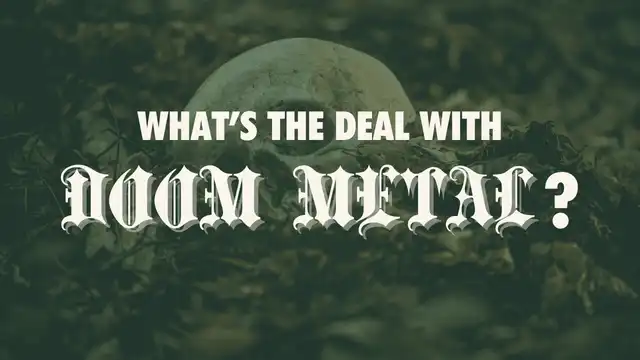What's the Deal with Doom Metal?


Doom metal is one of the heaviest, slowest, and most atmospheric genres within the metal scene, known for its haunting themes and bone-crushing riffs. Emerging from a love for the slow, menacing riffs of early heavy metal, doom metal has grown into a genre all its own with a dedicated fanbase. This article delves into doom metal’s origins, defining characteristics, iconic bands, and the guitar gear that brings this music to life. So whether you're a doom aficionado or new to the genre, let's explore the slow, heavy depths of doom metal.
The Early Days of Doom
Doom metal's roots go back to the late 1960s and early 1970s, particularly with Black Sabbath, whose slow, blues-influenced style and dark themes pioneered the sound. Tracks like Black Sabbath, N.I.B., and Electric Funeral introduced a newfound heaviness and an atmosphere of dread that contrasted sharply with the faster tempos and optimistic themes of rock music at the time.
Black Sabbath's lead guitarist, Tony Iommi, is often credited with defining doom metal’s characteristic “wall of sound.” Iommi famously used down-tuned guitars, which deepened the sound and provided more resonance. His use of down-tuning arose out of necessity, as he lost the tips of two fingers in an accident, leading him to use lighter strings and lower tunings to ease his playability. This innovation would become a hallmark of doom metal.
Doom metal truly began to take form in the 1980s, as bands took the sludgy, slow tempo and dark tone pioneered by Black Sabbath and made it even heavier and slower. Pentagram, an American band formed in the early '70s, also played a crucial role, adding even darker themes and a heavier atmosphere. By the late '80s and early '90s, bands like Candlemass, Saint Vitus, and Trouble had solidified doom metal as its own genre, shaping it into what fans know and love today.
Defining Doom: Style & Sound
Doom metal is defined by its slow tempos, heavy, low-tuned riffs, and dark, melancholic themes. The genre often explores despair, dread, and existential angst, reflected in both its lyrical content and its sound. Unlike faster genres like thrash or death metal, doom metal takes its time, building tension and allowing listeners to fully absorb the intensity of each note.
Most doom metal songs are lengthy, often surpassing the seven-minute mark to create an immersive and hypnotic experience. The guitar riffs are typically played in alternate tunings like Drop B or Drop C, which deepen the sound and bring out the genre’s signature thickness. The drumming is slow and pounding, and the vocals range from mournful wails to demonic growls, depending on the sub-genre.
Doom metal also often incorporates elements from other styles, creating several sub-genres:
Traditional Doom: True to the early Sabbath influence with straightforward riffing and blues influence (e.g., Saint Vitus).
Funeral Doom: Extremely slow and atmospheric, creating an almost trance-like effect with minimalist instrumentation (e.g., Skepticism).
Sludge Doom: Incorporates the abrasive qualities of punk with a raw, gritty sound (e.g., Eyehategod).
Stoner Doom: Has a psychedelic influence, with fuzz-heavy riffs and a more relaxed, hypnotic feel (e.g., Sleep).
Founding Fathers and Iconic Bands of Doom Metal
1. Black Sabbath
The undisputed originators, Black Sabbath laid the groundwork with their early albums. Paranoid (1970) features doom-inspiring tracks like “Electric Funeral” and “Hand of Doom.” Their debut self-titled album, Black Sabbath (1970), is another cornerstone, with its ominous tone and slow, crushing riffs.
2. Pentagram
Though less mainstream than Sabbath, Pentagram is a revered name among doom fans. Known for their bluesy riffs and dark atmosphere, songs like “Forever My Queen” and “Relentless” became cult classics. Their album Relentless (1985) is a must-listen for any doom enthusiast.
3. Candlemass
Hailing from Sweden, Candlemass is known for pioneering epic doom metal, marked by operatic vocals and grandiose compositions. Their album Epicus Doomicus Metallicus (1986) remains one of the most influential doom records of all time, with tracks like “Solitude” showcasing the genre’s emotional intensity.
4. Saint Vitus
As one of the earliest American doom bands, Saint Vitus brought a punk influence to doom, with simple but powerful riffs and rebellious themes. Their self-titled album Saint Vitus (1984) is essential listening, with “Born Too Late” standing out as a doom anthem.
5. Sleep
Known for their hypnotic, stoner-doom style, Sleep’s Dopesmoker (2003) is a legendary album consisting of one continuous, hour-long track. This album exemplifies the genre’s slower tempos, fuzzed-out riffs, and dedication to creating an immersive sonic experience.
Implements of Doom: Preferred Gear
The guitar sound in doom metal is just as important as the songwriting itself. Most doom metal guitarists gravitate toward heavy, down-tuned guitars with high-output pickups that handle low frequencies and heavy distortion.
1. Gibson SG
With its deep, warm tone and slim neck, the Gibson SG is a favorite in doom metal. Tony Iommi of Black Sabbath is famously associated with this model, as its lighter body and aggressive sound suit the genre’s demands.
2. Epiphone Les Paul
Known for its rich sustain and heavy tone, the Les Paul is another favorite for doom. Its thick sound helps carry the slow, droning riffs typical of the genre. Many doom guitarists opt for Epiphone models for affordability without sacrificing tonal depth.
3. Baritone Guitars
Baritone guitars, with their longer necks and extended scales, handle lower tunings excellently, allowing guitarists to tune even lower without sacrificing string tension. Brands like ESP and Schecter make popular baritone models used in doom metal.
4. Alternate Tunings
In doom, Drop B and Drop C are among the most common tunings, as they provide the perfect balance between heaviness and clarity. Some guitarists tune even lower, down to A standard or Drop A for an extra-thick, resonant sound. The exact tuning choice often depends on the guitarist’s preference and the overall tone of the song.

Doom Culture and Community
Doom metal fans often describe the genre as a kind of “therapy” — a way to explore darker emotions in a cathartic, immersive way. The culture around doom is relatively laid-back and welcoming, often with a communal and DIY spirit. Doom metal concerts are known for their powerful, slow performances, allowing listeners to feel each chord and vibration as it resonates through the crowd.
Doom festivals like Roadburn in the Netherlands or Maryland Doom Fest in the U.S. gather fans from all over, highlighting how devoted the community is to the genre. The culture values authenticity, passion, and a deep love for the music, creating an environment where both newcomers and die-hard fans can feel at home.
Descent Into Doom
Doom metal may not be for everyone, but for those who love it, it offers an unmatched intensity and a deep, cathartic connection. Whether you’re exploring the genre through classic albums or picking up a guitar to play those heavy riffs, doom metal remains a powerful, resonant style of music that stands the test of time.
At Stringjoy we're proud to provide strings spec'd for doomy dropped tunings, extended ranges, and all means of baritones. So go ahead - explore, experiment, and enjoy the journey through the slow, sludgy sounds of doom — the genre where darkness truly becomes music.
Other Posts you may like

Guitar Strings Order: How the Guitar is Tuned and Why

Two Handed Tapping: Our Top 8 Tappers of All Time

Which Guitar Strings Wear Your Fret Wire Down More?

What is Nashville Tuning? Its History, Best Guitar Strings & Uses

Guitar Scale Length Explained: String Tension & Playability

What Guitar Strings I Used To Play...
0 Responses
Leave a Reply
Your email address will not be published. Required fields are marked *

